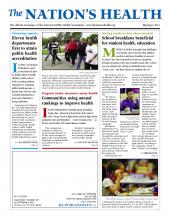While seat belt use is encouraged no matter where a driver goes, a recent study reveals drivers who only buckle up occasionally do it less when traveling on lower speed roads.
The study, published in January in Accident Analysis and Prevention, examined more than 150,000 trips among 100 vehicles in northern Virginia and Washington, D.C.
“We’re spending a lot of money on educational campaigns, (such as) Click It or Ticket, and there’s still a group of people that aren’t responding to that,” said, Julie McClafferty, MS, a study author and data reduction group leader with the Virginia Tech Transportation Institute. “Is there that middle group that sometimes do and what’s different about them?”
The study broke down seat belt use into three categories: infrequent, occasional and consistent. Occasional users were drivers who buckled up in 40 percent to 85 percent of trips, the study said. Those users wore seat belts about 73 percent of the time when on roads with a 30 mph average speed limit, compared to 89 percent of the time when on highways where the limit was 50 mph or more, the study said.
Seat belt use contributes to a 50 percent reduction in death and serious injury, according to the Centers for Disease Control and Prevention. Seat belts are used 88 percent of the time in states with primary enforcement laws, compared to 79 percent of the time in states without those laws, according to CDC. Primary enforcement laws allow police officers to stop drivers solely because they are not wearing seat belts.
“There may be a misconception that when you drive on lower speed roads your risk is lower, and when you drive on higher speed roads your risk is higher,” McClafferty told The Nation’s Health. “Clearly that’s not an accurate perception of risk, but it’s a common one.”
Occasional seat belt users did not buckle up as much when they were on “secondary roads,” such as neighborhood streets, and took more trips per day, McClafferty said. One reason behind the occasional use might be the convenience factor. Repeatedly buckling and unbuckling might be bothersome for some people who are taking frequent trips, she said.
“I think there’s still a group of the population that thinks they’re better off not wearing their seat belt because they won’t get trapped in the car if they get in an accident,” McClafferty said. “I think that’s definitely the reason for some people, but it’s a fairly prevalent reason.”
The study found that for men younger than age 40, there were about just as many who were infrequent users as occasional users. Twenty-two percent of men younger than 40 used seat belts infrequently, compared to 24 percent of men younger than age 40 who wore them occasionally. Infrequent users were defined as buckling up for 30 percent of trips or less. Overall, men are 10 percent less likely than women to buckle up, according to CDC.
Younger women may also need to be targeted for future educational campaigns, McClafferty said, as 21 percent of women younger than age 40 buckled up infrequently.
For occasional seat belt use, about 16 percent of women younger than age 40 buckled up, compared to about 35 percent of women age 40 and older, the study said.
Primary seat belt laws are increasing seat belt use nationwide, but there is still an inaccurate understanding of the risk level that comes with driving anywhere regardless of distance and speed, McClafferty said. Education campaigns are necessary to reach people who use seat belts inconsistently.
“Just because you’re driving on a slower road doesn’t necessarily make you any safer without a belt,” McClafferty said.
For more information, visit www.sciencedirect.com/science/article/pii/S000145751200231X.
- Copyright The Nation’s Health, American Public Health Association









